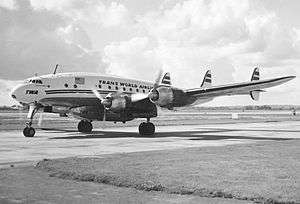TWA Flight 903
TWA Flight 903 was a regularly scheduled flight from Bombay International Airport, India to New York-Idlewild Airport, via Cairo-King Farouk Airport and Rome-Ciampino Airport.
 A TWA L-749A Constellation similar to the accident aircraft | |
| Accident | |
|---|---|
| Date | August 31, 1950 |
| Summary | Forced landing due to catastrophic engine failure and fire |
| Site | Ityai el Barud, Egypt |
| Aircraft | |
| Aircraft type | Lockheed L-749A Constellation |
| Aircraft name | Star of Maryland |
| Operator | TWA |
| Registration | N6004C |
| Flight origin | Bombay International Airport, India |
| 1st stopover | Cairo-King Farouk Airport |
| 2nd stopover | Rome–Ciampino Airport |
| Destination | New York-Idlewild Airport |
| Occupants | 55 |
| Passengers | 48 |
| Crew | 7 |
| Fatalities | 55 |
| Survivors | 0 |
The Star of Maryland, a Lockheed L-749A Constellation, flew the route on the night of 31 August 1950. It departed Cairo at 23:35 for Rome with 55 persons aboard, (48 passengers and seven crew members), in good weather.
As Flight 903 was climbing at 10,000 ft (3,000 m), the crew reported that its number three engine was on fire and that they needed a priority return to Cairo. As the plane was returning to Cairo, the engine separated from the aircraft, forcing the crew to attempt a forced landing in the desert about 65 miles NNW of Cairo. The airliner went down near the village of Ityai el Barud at the rim of the Western Desert, killing all 55 on board.
Searchers found the wreckage strewn over 500 yd (460 m) after trekking 15 mi (24 km) over hot sands to reach it, where the aircraft wreckage was found almost completely burnt out. The bodies of the victims were badly charred, delaying identification. A United Press International correspondent reported that the plane had smashed into a narrow-gauge railway in hitting the ground and had plowed up a considerable stretch of track.
Among those killed were Egyptian film star Camelia; Polish architect Maciej Nowicki, who had been working on the design of the new city of Chandigarh; and Indian mathematician S. S. Pillai, who was on his way to participate in the International Congress of Mathematicians at Harvard University.
After an intensive investigation, the probable cause of the crash was cited to be failure of the rear master rod bearing on the number three engine. The failure caused the rear crankpin to overheat and fail, whereupon all the rear connecting rods failed, tearing through the cylinder walls and crankcase. In the process, oil lines were torn open, which caused the fire. Sludge buildup in the crankpins, blocking oil flow was thought to be the root cause, which resulted in improved oil screens and the implementation of a crankpin plug, as well as revised oil change intervals.[1]
References
- Notes
- Gero, David (1996). Aviation Disasters (2nd ed.). Sparkford: Patrick Stephens Ltd. ISBN 1-85260-526-X.